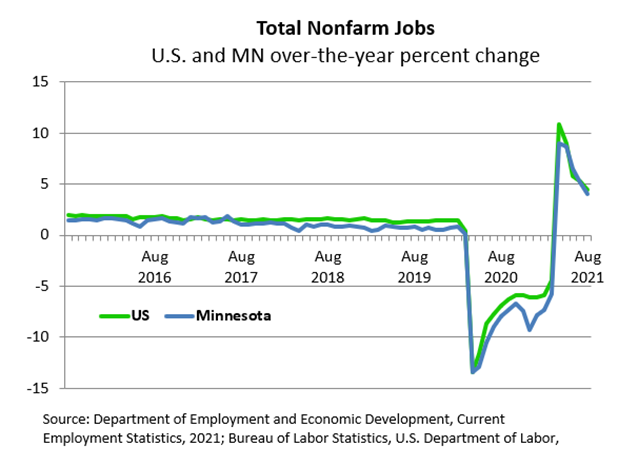by Nick Dobbins
September 2021
Employment in the Minneapolis-St. Paul-Bloomington MSA was up by 3,474 (0.2%) over the month in August on an unadjusted basis, which is roughly in line with recent August movement in the area. Mining, Logging and Construction had the largest proportional growth, up 1.8% (1,698 jobs) with Specialty Trade Contractors adding 5,751 jobs (9.7%). Leisure and Hospitality added 2,852 jobs (1.7%), and Trade, Transportation, and Utilities added 3,511 jobs (1%), with much of that growth coming in Wholesale Trade (up 2,179 jobs or 3.5%). Four supersectors lost jobs on the month, with the largest real and proportional declines coming in Government employment (down 4,462 jobs or 2%).
Over the year the metro area added 72,300 jobs (3.9%), which was down from the 4.8% over-the-year growth posted in July. August's annual growth was greatest in Leisure and Hospitality, which added 29,227 jobs (20.3%). Mining, Logging, and Construction employment was up 6.2% (5,647 jobs), and Other Services was up 6.1% (4,196 jobs). Two supersectors lost jobs on the year, as Information was down 6.1% (1,996 jobs), and Financial Activities was down 0.2% (396 jobs).
The Duluth-Superior MSA lost 332 jobs (0.3%) on the month in August. The largest real decline came in Leisure and Hospitality (down 380 or 2.6%) and the largest proportional decline was in Information (down 3.6% or 38 jobs). Four supersectors added jobs, with Financial Activities up 1.5% (80 jobs) and Government adding 150 jobs (0.6%).
Over the year the Duluth area added 6,198 jobs or 5%. It was the highest proportional over-the-year growth of any metro area primarily in Minnesota. Leisure and Hospitality had the largest proportional growth of any supersector, up 13.3% or 1,694 jobs, but the largest real employment growth came in Educational and Health Services, which added 1,738 jobs (5.9%). Manufacturing employers added 553 jobs or 7.2%. Just one supersector in the area lost jobs on the year as Information employment was off by 4.3% or 46 jobs.
The Rochester MSA added 341 jobs (0.3%) in August. Government employment was up 1.1% (141 jobs) with all that growth coming in Local Government (up 158 jobs or 1.5%). The largest real job growth was in Educational and Health Services, which added 300 jobs (0.6%). Five supersectors lost jobs on the month with Leisure and Hospitality off by 109 jobs (1.1%) and Information down 2.3% (30 jobs).
Over the year Rochester added 4,621 jobs (3.9%), after being up 5.3% over the year in July. Leisure and Hospitality employment was up 12.2% (1,180 jobs). Educational and Health Services added 1,911 jobs (3.7%). Trade, Transportation, and Utilities added 537 jobs or 3.2%, with most of that growth coming in Retail Trade (up 539 jobs or 4.6%). Three supersectors lost jobs on the year, with Manufacturing down 148 jobs (1.4%) and Information down 87 jobs (6.4%).
Employment in the St. Cloud MSA was down by 0.5% (508 jobs) in August. It was the steepest proportional monthly decline of any MSA primarily in Minnesota. The monthly losses were largely driven by two supersectors, as Government employers lost 272 jobs (2%) with declines in every component sector, and Trade, Transportation, and Utilities lost 229 jobs (1.1%) with the losses there driven primarily by Retail Trade which was off by 171 or 1.3%. Educational and Health Services added 109 jobs (0.5%) on the month.
Over the year St. Cloud area employers added 2,155 jobs (2.1%), which was the lowest over-the-year growth rate of any MSA primarily in the state although stronger than Grand Forks-East Grand Forks, which is primarily in North Dakota. Employment in Leisure and Hospitality was actually down on the year, off by 486 or 6.7%, by far the largest real and proportional decline of any supersector in the area at a time when Leisure and Hospitality employment statewide is up nearly 20% over the year. Educational and Health Services added 1,080 jobs (5.4%), the largest real job growth in the area.
The Mankato-North Mankato MSA added 295 jobs (0.5%) over the month in August. It was the highest proportional monthly growth of any MSA primarily in Minnesota, trailing Grand Forks-East Grand Forks, which is primarily in North Dakota. Private sector employers added 347 jobs (0.8) while public sector employers lost 52 jobs (0.6%). Service providers added 327 jobs (0.7%) and goods producers lost 32 jobs (0.3%).
Over the year the Mankato-North Mankato area added 2,538 jobs (4.8%). Service providers drove the growth, adding 2,487 jobs (5.8%), while goods producers added 51 jobs (0.5%). The private sector added 2,015 jobs (4.6%), and public sector employers added 523 jobs (6.2%).
The Fargo-Moorhead MSA added 725 jobs (0.5%) over the month in August. Government employers drove the growth, adding 1,144 jobs (7.5%) with strong growth at both the Local (10.8%) and State (6.5%) levels. Professional and Business Services employment was off by 1.2% or 167 jobs. Educational and Health Services lost 277 jobs (1%).
Over the year the Fargo-Moorhead area added 6,387 jobs (4.7%). Leisure and Hospitality added 2,289 jobs (19.2%), the largest real and proportional growth in the area. The only supersector to lose jobs was Information, which was off by 3.1% or 93 jobs.
The Grand Forks-East Grand Forks MSA added 298 jobs or 0.6% in August. It was the largest proportional monthly growth of any MSA in the state. Trade, Transportation, and Utilities drove the growth, adding 369 jobs (3.7%), with all of that growth coming from Retail Trade (up 444 or 7.2%).
Over the year the Grand Forks-East Grand Forks MSA added 847 jobs or 1.7%. It was the worst proportional over-the-year growth of any MSA in the state. Manufacturing employers lost 365 jobs or 8.8%, which was the largest real and proportional decline of any supersector and likely held down the MSAs overall annual job growth.
